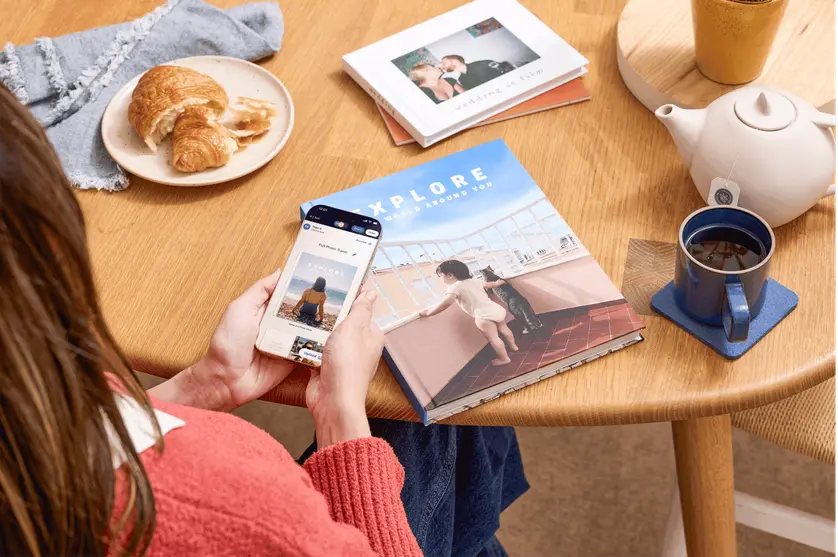In the pre‑screen era, life was marked by handwritten notes, meticulously arranged scrapbook pages, and the anticipation of photos emerging from the darkroom.
Now people in the U.S. experience more than 7 hours of screen time daily and function in a loop of micro‑rituals: Wake up. Grab phone. Check texts. Make coffee. Check IG DMs. Scroll TikTok. Open email.
It’s no wonder there’s an undercurrent of digital burnout building.
At Mixbook, we know that digital photography didn’t make printed photos or physical photo albums obsolete, and social media sharing hasn’t eliminated in-person interactions with family and friends. The ascent of these newer technologies has instead expanded opportunities for self-expression and sharing through photos and custom photo products.
But one thing is more obvious than ever: the digital revolution and social media has made us crave print again.
From scrapbook to scroll to…Mixbook?
Today’s consumers don’t have to choose the old or the new, the digital or the physical; instead they curate their own experiences. Mixbook’s products are driven and inspired by their choices.
David Newhoff, Mixbook’s Chief Product Officer, describes one of the most interesting recent trends we’re watching:
“Research shows Gen Z is printing more than older generations, turning their digital moments into something they can actually hold onto. They see value in these physical time capsules. It’s a permanence that’s new and appealing.”
In a world dominated by digital expression, something surprising is happening—young people are rediscovering the power of the printed photo. This trend raises a lot of questions. Does it represent a rejection of social media? Or is it inspired by social media? In what ways has social media sparked a renewed interest in physical storytelling?
The digital-native shift toward tangibility
Key stat: Gen Z prints twice as many photos as older generations.
Further, the New York Post has reported on the trend of “Gen Z ditching smartphones for point and shoot cameras.”
As “digital natives,” Gen Z have never known a world without smartphones and social media. Yet, they’ve still experienced—and been the driving force behind—major shifts in the digital realm. Social media has taught younger generations how to frame, curate, and share. Yet the social media world is lacking in tangibility. Now, Gen Z wants a format with permanence.
Increasing demand for older models of digital cameras (and film cameras, too) reflects a desire for fewer, more unique photos, taken and curated mindfully. This is in contrast to the easy, instant perfection of high-end smartphone pics, each glanced at for mere seconds before disappearing into the endless archives of a photo reel.
In a world of unrelenting exposure to flawless, filtered, only-on-screen smartphone pics, so many of which are posted for self-promotion rather than authentic connection, physical printed photos offer grounding and presence. Social media “likes” are fleeting and fickle. Sitting with a friend and flipping through a photo book you designed, printed, and arranged on a coffee table or bookshelf is a totally different experience.
“Social media has given people the language of visual storytelling... but younger generations are craving something more lasting than a disappearing story or a quick like... For digital natives, physical memories offer something profoundly grounding—permanence, presence, and emotional resonance.” — David Newhoff, Mixbook CPO
The resurgence of photo printing and storytelling should be considered through the lens of emotional practice, and not simply outputs. Physical photo books are emotional artifacts that feel rare and special amid a fast-paced digital world.
Mixbook emphasizes tools that make it quicker and easier than ever to create a photo book. However, this doesn’t diminish the value of a Mixbooker’s emotional and intellectual input. Choosing photos and themes and customizing the design requires a deliberate approach to storytelling. As a result, the physical photo book becomes a tangible, permanent representation of the memories it holds within.
The new role of platforms like Mixbook
Mixbook is not a rival, nor an alternative to social media. Rather, it’s a complementary platform that connects the digital and physical realms we all occupy. Social media platforms present disconnected snippets of stories, whereas Mixbook helps tell and preserve stories as a whole.
Here are a few ways in which Mixbook is responding to the shifting trend toward re-embracing physical media:
- Developing tools for transforming social media stories/posts into something more permanent
- Collaborating with aesthetic-forward designers (like Martha Stewart) to embrace everyone’s more aesthetic, individualized tastes
- Offering mobile-friendly workflows that meet digital-first users where they are
The takeaway: Turning fleeting moments into lasting stories
Social media may have sparked the desire for self-expression, but it’s the physical form that gives it legacy. At Mixbook, we believe the future of digital storytelling lies at the intersection of tech, memory, and meaning. Gen Z and older generations—let’s all meet in the middle!
